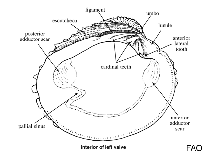Nutricola lordi (Baird, 1863)
Lord dwarf-venus| Native range | All suitable habitat | Point map | Year 2050 |

|
| This map was computer-generated and has not yet been reviewed. |
| Nutricola lordi AquaMaps Data sources: GBIF OBIS |
Upload your photos
Google image | No image available for this species;
drawing shows typical species in Veneridae.
Google image | No image available for this species;
drawing shows typical species in Veneridae.
Classification / Names Common names | Synonyms | CoL | ITIS | WoRMS
Bivalvia | Venerida | Veneridae
Environment: milieu / climate zone / depth range / distribution range বাস্তুসংস্থান
; গভীরতার পরিসীমা 0 - 70 m (Ref. 95344). Temperate; 56°N - 5°S, 153°W - 106°E
বিতরণ দেশ সমূহ | এফ এ ও এলাকাসমূহ | বাস্তুতন্ত্র | দৃষ্টিগোচর | প্রচলন
Pacific Ocean: Bering Sea, Gulf of Alaska, Puget Sound, Baja California Sur (Ref. 95344).
Length at first maturity / আকৃতি / ওজন / Age
Maturity: Lm ? range ? - ? cm Max length : 1.0 cm SHL পুরুষ/ লিঙ্গ অনিধর্ারিত ; (Ref. 95344)
Life cycle and mating behavior পরিপক্কতা | প্রজনন | ডিম ছাড়া | ডিমসমূহ | ডিম্বধারন ক্ষমতা | শুককীট
Members of the class Bivalvia are mostly gonochoric, some are protandric hermaphrodites. Life cycle: Embryos develop into free-swimming trocophore larvae, succeeded by the bivalve veliger, resembling a miniature clam.
Main reference
সূত্র সংখ্যা | সমম্বয়কারী | সহযোগী
Pacific Northwest Shell Club. 2014. (Ref. 94906)
IUCN Red List Status (Ref. 130435: Version 2024-1)
CITES status (Ref. 108899)
Not Evaluated
CMS (Ref. 116361)
Not Evaluated
Threat to humans
Human uses
| FishSource |
হাতিয়ার
আরো তথ্য
Trophic Ecology
খাদ্যসামগ্রী
পথ্য
খাদ্য গ্রহণ
বরাদ্দ
শিকারী প্রাণী সমূহ
পথ্য
খাদ্য গ্রহণ
বরাদ্দ
শিকারী প্রাণী সমূহ
Ecology
Population dynamics
বৃদ্ধি
Age/Size
Length-weight
Length-length
Length-frequencies
Mass conversion
নির্বাচন
প্রাচুর্য
Age/Size
Length-weight
Length-length
Length-frequencies
Mass conversion
নির্বাচন
প্রাচুর্য
Life cycle
Distribution
Human Related
এ্যাকুয়াকালচার নকশা
Stamps, Coins Misc.
Stamps, Coins Misc.
Outreach
Taxonomy
References
ইন্টারনেট সুত্র
BHL | BOLD Systems | CISTI | DiscoverLife | FAO(Publication : search) | Fishipedia | GenBank (genome, nucleotide) | GloBI | Gomexsi | Google Books | Google Scholar | Google | PubMed | জীবন বৃক্ষ | Wikipedia (Go, অনুসন্ধান ) | জুলজিকাল রেকর্ড
Estimates based on models
Preferred temperature
(Ref. 115969): 5.7 - 12.8, mean 9.3 (based on 162 cells).



